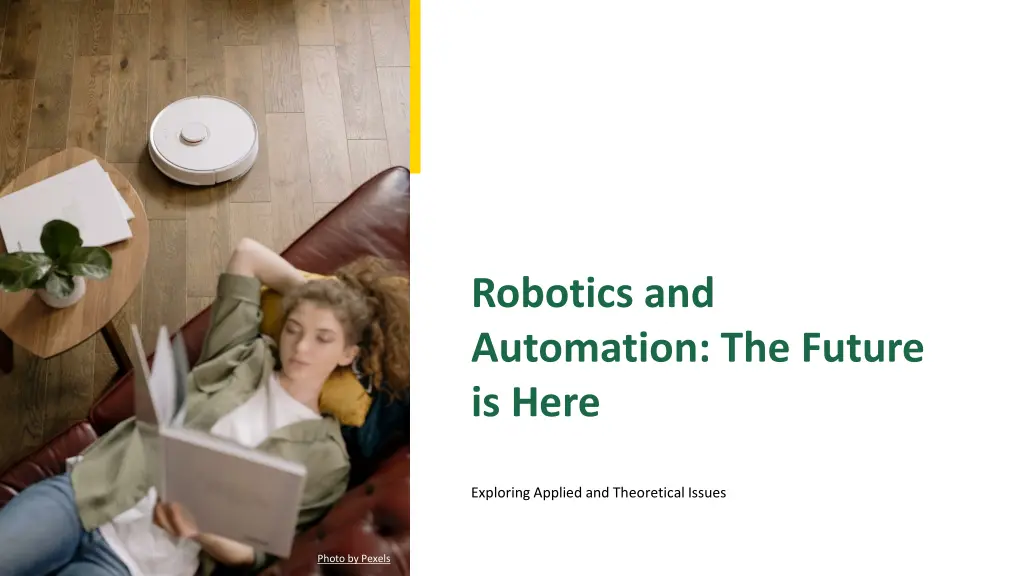
Exploring the Future of Robotics and Automation
Discover the impact of robotics and automation on various industries, from healthcare to logistics. Learn about the role of AI in robotics, theoretical foundations, challenges, and future trends. Explore how robotics is revolutionizing workflows and enhancing efficiency in diverse fields.
Download Presentation

Please find below an Image/Link to download the presentation.
The content on the website is provided AS IS for your information and personal use only. It may not be sold, licensed, or shared on other websites without obtaining consent from the author. If you encounter any issues during the download, it is possible that the publisher has removed the file from their server.
You are allowed to download the files provided on this website for personal or commercial use, subject to the condition that they are used lawfully. All files are the property of their respective owners.
The content on the website is provided AS IS for your information and personal use only. It may not be sold, licensed, or shared on other websites without obtaining consent from the author.
E N D
Presentation Transcript
Robotics and Automation: The Future is Here Exploring Applied and Theoretical Issues Photo by Pexels
01 The Rise of Robotics Table of Contents 02 Understanding Automation 03 Applications of Robotics 04 The Role of AI in Robotics 05 Theoretical Aspects of Robotics 06 Challenges in Robotics 07 Future Trends in Automation 08 Robotics Education and Workforce 09 Ethics and Robotics 10 Thank You!
1 The Rise of Robotics A New Era Robotics is revolutionizing industries by integrating intelligent machines that enhance human capabilities and efficiency in various applications. From manufacturing to healthcare, robotics is transforming workflows and optimizing productivity while minimizing human error. The push for automation is driven by a desire for increased speed, precision, and safety in challenging environments. As technology advances, the future of robotics holds endless possibilities for innovation and development. Photo by Pexels
2 Understanding Automation What is Automation? Automation refers to the use of technology to perform tasks without human intervention, streamlining processes and enhancing efficiency. In both theoretical and applied settings, automation encompasses a wide range of technologies, including robotics, AI, and complex algorithms. Understanding its principles is crucial for designing systems that can adapt and respond to dynamic environments. Experts emphasize the importance of integrating theoretical knowledge with practical applications in automation. Photo by Pexels
3 Applications of Robotics Diverse Fields Robotic technology is utilized in diverse fields such as manufacturing, healthcare, agriculture, and logistics, each reaping unique benefits. In healthcare, robotic surgery offers precision and reduced recovery times, revolutionizingpatient care. In agriculture, robotics optimizes crop management and harvesting, increasing yield and sustainability. Automation in logistics streamlines supply chains, reducing costs and improving service delivery. Photo by Pexels
4 The Role of AI in Robotics Intelligent Systems Artificial Intelligence is integral to modern robotics, enabling machines to learn, adapt, and enhance their autonomous capabilities. AI empowers robots to perform complex decision-making tasks by analyzing vast amounts of data in real-time. The synergy between robotics and AI opens new avenues for innovation, leading to smarter, more capable machines. AI-driven robots are not just tools; they are partners in pushing the boundaries of what s possible. Photo by Pexels
5 Theoretical Aspects of Robotics Foundational Knowledge Robotics is rooted in multidisciplinary research including computer science, engineering, and cognitive science, providing a comprehensive framework. Theoretical studies focus on algorithms, motion planning, and robot perception, which are essential for effective design and function. Understanding these principles allows engineers to create more efficient and resilient robotic systems. Theoretical advancements pave the way for practical applications, making research vital in this field. Photo by Pexels
6 Challenges in Robotics Navigating Complexities Despite advancements, the field of robotics faces challenges such as programming complexity, sensor reliability, and integration with existing systems. Ethical concerns around automation's impact on employment and privacy must be addressed as technology evolves. Continuous innovation is necessary to overcome these challenges and unlock the full potential of robotics. Collaboration among researchers, developers, and policymakers is essential for sustainable growth in robotics. Photo by Pexels
7 Future Trends in Automation What's Next? The future of robotics and automation is poised for significant growth, with trends like collaborative robots (cobots) gaining prominence. Emerging technologies such as 5G and edge computing will enhance robotic capabilities, enabling seamless connectivity and processing. Sustainability and green technologies are becoming integral to robotics design, focusing on reducingenvironmental impact. As these trends unfold, the landscape of automation will continue to evolve and inspire new generations of innovators. Photo by Pexels
8 Robotics Education and Workforce Preparing the Next Generation Educational institutions are integrating robotics into their curriculums to equip students with essential skills for the future workforce. Hands-on training and interdisciplinary programs foster creativity and innovation, crucial in a rapidly changing technological landscape. Investing in education ensures a skilled workforce capable of navigating the complexities of the robotics industry. Collaboration between academia and industry is key to addressing skills gaps and driving growth in robotics. Photo by Pexels
9 Ethics and Robotics A Critical Discussion The integration of robotics into society raises significant ethical issues that must be considered to ensure responsible development. Discussions around accountability, transparency, and bias in AI systems are vital to building trust in robotic technologies. Establishing ethical guidelines will guide the development and deployment of robotics in a way that benefits humanity. Engaging diverse stakeholders is crucial to addressing these ethical challenges effectively. Photo by Pexels
10 Thank You! For Your Attention Thank you for exploring the world of robotics and automation with us today! We hope this presentation has inspired you to think about the future of intelligentmachines and their applications. Let's embrace the opportunities and challenges that robotics brings to our lives. Feel free to reach out for any questions or collaborations. Photo by Pexels
